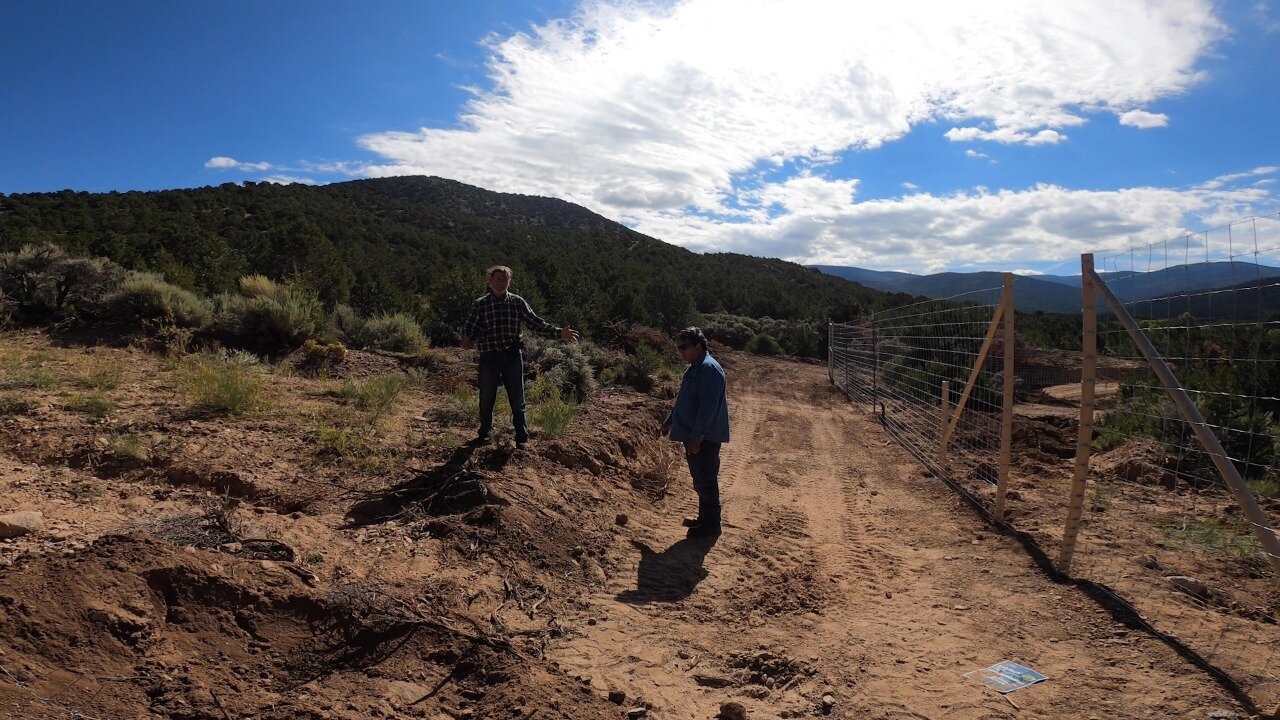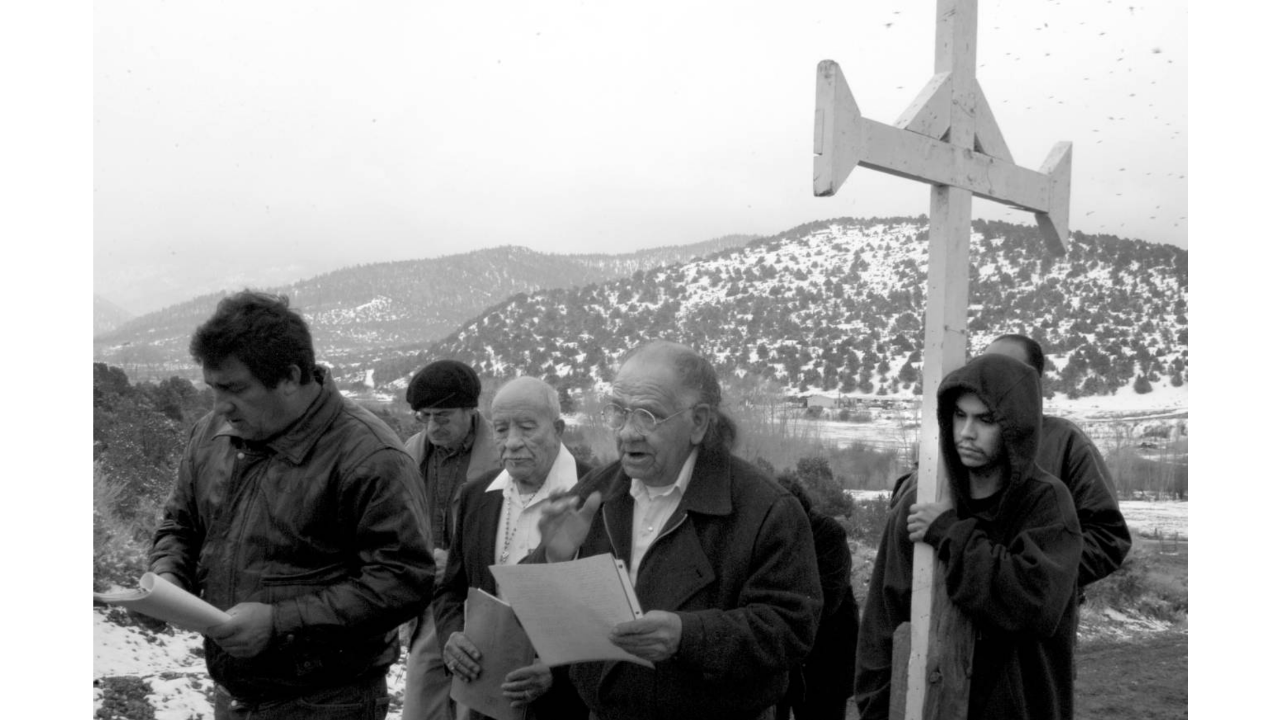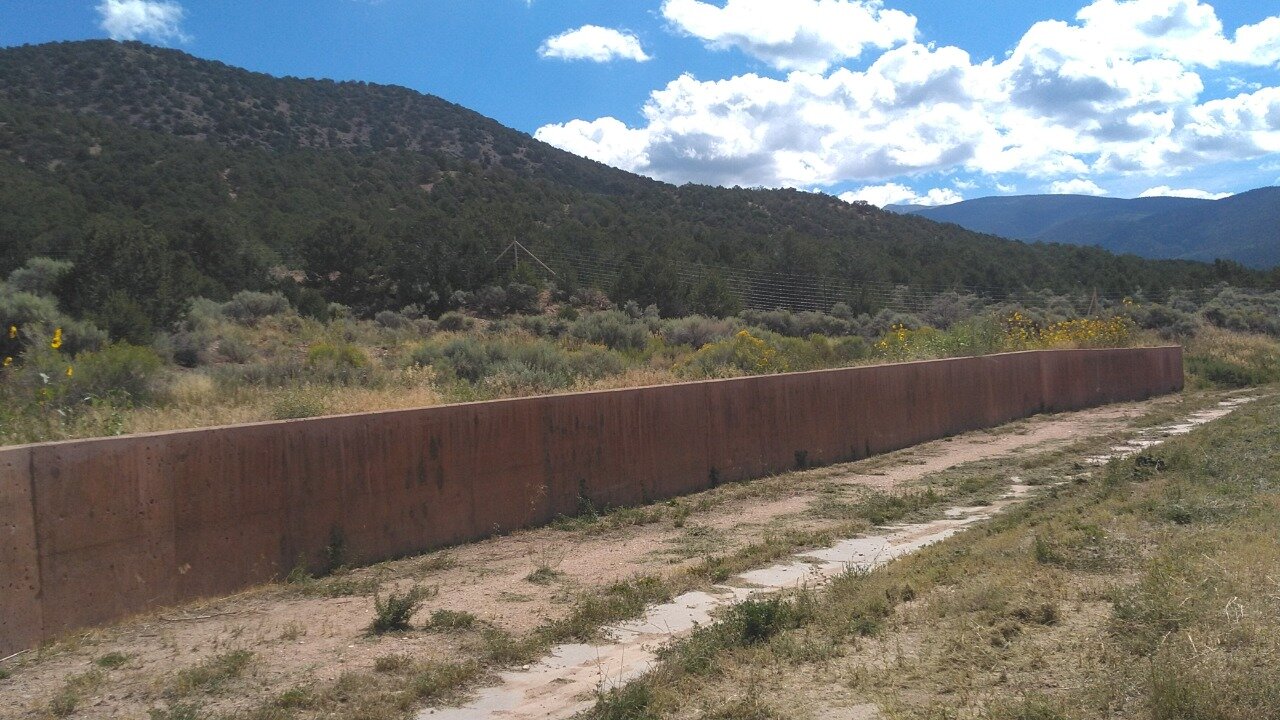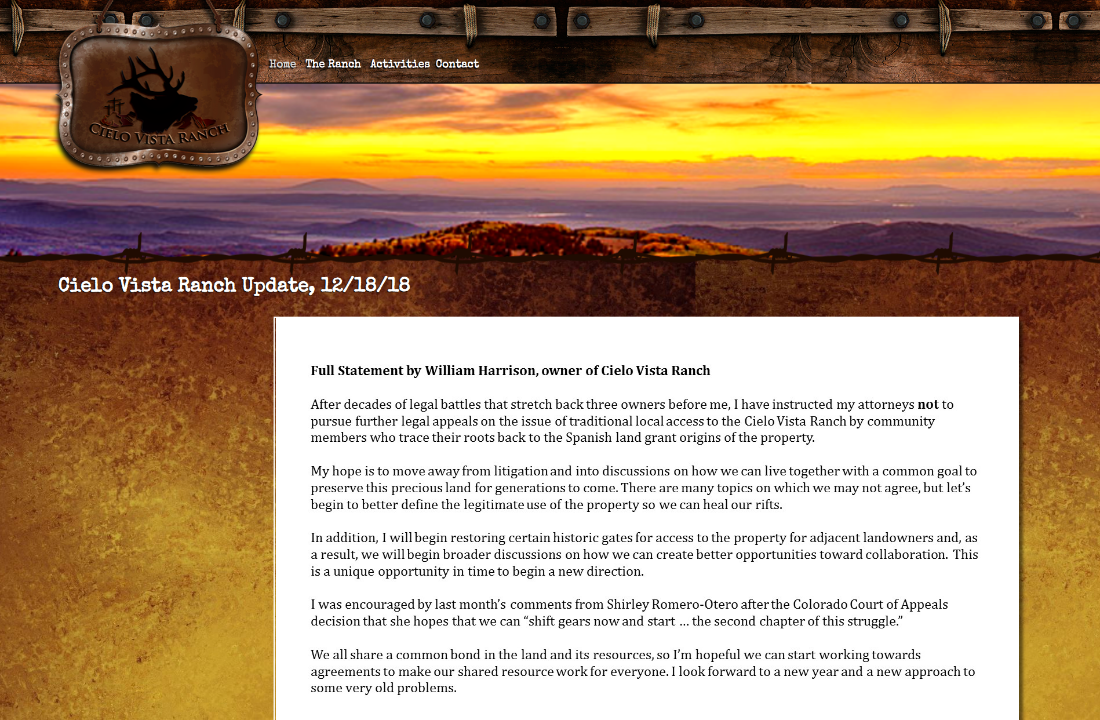Property fence interrupts 150-year-old religious pilgrimage

SAN FRANCISCO, Colo. — A religious ceremony—the last of its kind in Colorado—stands threatened by private property rights.
Each spring during Lent, a community gathers in a small village at the foothills of the Sangre de Cristo Mountains, as is has since the 1870s, for Via Crucis, or Stations of the Cross.
The annual Catholic pilgrimage recounts the memory of Jesus Christ's passion, death, and resurrection. Held on Good Friday, this spiritual tradition dates back centuries. The ceremony was brought to the region by settlers, or pobladores, from Mexico and Spain.
Now, the religious ceremony has an uncertain future due to the construction of a private fence across the path of the historic pilgrimage.
“When this area was being settled, there weren’t enough priests to have Mass for the community, and for baptisms,” said Arnie Valdez, a Hermano, or brother, of the San Francisco Morada for more than 20 years.
Los Hermanos Penitentes were the first lay ministers. There were once many groups throughout southern Colorado and northern and central New Mexico, Valdez said.
Upon settlement of these once Indigenous lands, “The Penitentes first established little oratórios, or prayer spaces,” said Valdez. Eventually, they built larger buildings, called Moradas—traditional community spiritual and meeting places.
“Morada means a place of dwelling, or a house, in Spanish,” said Valdez. “This is our House of God.”
During its peak, the San Francisco Morada had 73 Hermanos. Today, membership is down to just six. Hermanos still provide ceremonial blessings at special events and community gatherings.
On Good Friday during Holy Week, Hermanos pray all day, said Valdez. Together with the community, they perform an Encuentro, or Encounter of the Virgin Mary and Jesus. The Hermanos then lead the procession up the hill behind the Morada, carrying the Crucifix.
But the next ceremony will look—and feel—different than it has for the last 150 years.
An wildlife fence about 10 feet tall recently appeared on the Morada’s property line, along with an access road bulldozed straight through the Via Crucis path that had been worn by generations of elders and families.
Valdez points to the Calvario trail, worn from a century and a half of processions. “Talk about the sacred and profane,” he said. “The roadway created by the fence has desecrated and severed this holy ritual ground.”
The fence came out of nowhere, Valdez told Rocky Mountain PBS.
“We happen to share a common boundary with Cielo Vista Ranch. And it’s not the issue that they can’t build a fence—a fence is a use by right,” explained Valdez. “The reason we launched our complaint is because their activity impacts our property directly.”
“They did this without even letting the people know what’s going on,” said Charlie Maestas, a fourth-generation Hermano of 31 years. “I talked to them about it—but it didn’t do any good.”
“In other words, ‘You don’t mean anything to us,’” said Valdez.
“I feel like my freedom is violated,” added Maestas.
The hill that is integral to the ceremony lies beyond this property line—and now, beyond the fence. The Morada has used their historic cultural easement to access the hill and conduct the Via Cruces for 150 years.

Today, a 10-foot swath of the procession trail has been completely swept off the map. A fence divides one part of the trail from the next. The worn route of the procession path on either side of the fence is obstructed by a large mounds of dirt and vegetation debris. Valdez and Maestas struggle to climb the ungraded rise of the access road shoulder.
Valdez said they were granted a pedestrian gate to access the hill after conversations with the ranch foreman. But there was no assurance they would be able to continue to use the area — nor that buffalo would not quickly wipe out the remainder of the historic ceremonial trail.

During the procession, the Hermanos lead alabados—sacred Spanish hymns dating back to 18th century colonial New Spain.
At the top of the hill, a hole is dug, and the large wooden Crucifix is placed and left for the duration of Holy Week, Valdez said. Before descending the hill, the community kneels and prays.
The soft dirt where the cross has stood for so many years is easy to spot. With plans for buffalo here, the stewards of this cultural site are distressed, worrying the hill’s one-of-a-kind history will be lost forever.
“It’s important for us to highlight the Morada. This is the last one that survives in Colorado that has active membership,” said Valdez. “It’s sad to see it now pressured in addition to all the other things that we face in our society.”
Though traditions practiced by the Hermanos largely remain private, Valdez said, showing what has happened to this cultural site is critical.
“Private ownership of the mountain has imposed a hardship on the community, and continues to, with even more vigorous pressure and activity taking place now. It’s kind of accelerated, in a way,” said Valdez.
Maestas said this is the worst thing he has seen happen in the area in terms of changes to the cultural landscape.
“The Morada is part of my life,” said Maestas. “It brings tears to my eyes.”

“This is just a small microcosm of what's going on,” Valdez explained. “The rest of the properties along the road here are subject to the same thing.”
“I can see them having a fence,” said Maestas. “But this area right here isn’t really made for grazing buffalo. It’s mostly a wildlife corridor for deer and elk.”
Valdez suggested the fence may help Cielo Vista Ranch’s commercial hunting operation by limiting natural wildlife migration, particularly deer and elk that travel down to nearby San Francisco Creek.
“In terms of the ranch’s private guided tours, this ensures the animals stay on their property,” Valdez said. “Hunters will probably have more success because it will be easier for them to contain the animals.”
“Not only has the fence building activity disrupted our religious practices, and the wildlife, but it has damaged the piñon and Juniper forest,” said Valdez. “You can see how the bulldozers traversed the landscape, cutting across the arroyos, and leaving a lot of potential channels for erosion and sedimentation that will be draining to the county road—and potentially the Morada structure.” He went on to say they're already facing that issue.
Valdez said the disturbance of fragile alluvium soil prone to erosion may undermine efforts already put in place by the Morada to contain the highly erodible land.
“It is such a sacred site,” said Catherine Stroh, executive director of the Colorado Historical Foundation, a nonprofit that connects people with resources to preserve history. “It’s different than just a fence being built between ranches.”
With the help of the History Colorado State Historical Fund, the Morada was able to complete structural renovations—flooding and age had damaged the building—and place flood mitigation measures on the property, including a low retention wall at the base of the hill.

Stroh also said partnership with the foundation allowed the Morada to join into a voluntary historic preservation easement aligning with its property boundaries.
“What that means is we’ve been granted the legal right to prevent any destruction or unapproved development within the boundaries of the property,” said Stroh. “The tricky thing here is, we don’t have legal purview on the other side of the fence. Our easement does not include the views beyond the fence.”
She acknowledged that the landscape and the surroundings of cultural sites lend to their context and meaning, “especially in this case.”
“Unfortunately, it’s a conundrum with historic preservation,” said Stroh. “In many cases, development will come right up to the edge of the property line, destroying the history that surrounded the legal boundaries of that historic site. It can make that site kind of lose its specialness in a way, because you can’t see where it was in the context of everything around it.”
“There is no requirement in the county to get a permit to build a fence,” said Ben Doon, Chief Administrative Officer of the Costilla County Board of Commissioners. Doon said the county did issue a violation notice to the owner of Cielo Vista Ranch for not obtaining a permit for the grading work done along miles of fencing, then received correspondence from the owner’s attorneys stating exemption from this permit as an agricultural livestock operation, because of an active buffalo herd.
“Since Cielo Vista seems to have no intention to get [grading] permits,” said Doon, “the next step would be to take them to court.”
Valdez believes the county’s Land Use Code requires an additional study of the fence’s affects on the watershed, wildlife, and cultural practices. He knows the Land Use Code well—he helped develop and initiate the code in 1998 as an employee of the county. As land use administrator, Valdez worked with the community to update the Comprehensive Plan and Land Use Code and to implement zoning.
With proper communication, Valdez said, these issues could have been mitigated.
Stroh said the ranch’s lack of communication about the fence and disruption to the site, “seem to go against the whole culture of the settlement of the [San Luis] Valley, where neighbors really had to lean in and help each other and be cooperative in their efforts in order to be successful.”
Valdez said a lack of cooperation between owners of the Cielo Vista Ranch and community members goes back over 60 years.
The land was once the historic Sangre de Cristo Land Grant, a communal mountain tract accessible to community members to hunt, fish, graze, and collect timber and firewood. In 1961, the mountain tract—including Culebra Peak—was privatized and closed to the public. The land’s first owner immediately began fencing off the property, Valdez said.
“There’s been a lot of tension ever since the fencing off in 1961,” said Valdez. “That was the first act of the community being segregated and cut off from the landscape. This is just reminiscent of what happened there.”
Privatization of the mountain and loss of historic rights to natural resources pit the community against a series of millionaires and billionaires who have since owned the land, resulting in generations of court battles to regain the mountain’s resources for subsistence living.
In 2002, the Colorado Supreme Court decided that landowners have rights to grazing and firewood on the still-private ranch.
Previous owners of the ranch include lumber baron Jack Taylor, who extensively commercially logged the mountain; tarnished Enron executive Lou Pai; Texan land speculator Bobby Hill; and now, William Harrison, heir to one of Texas’ largest oil enterprises.
After buying the land for $105 million in 2018, Harrison pledged publicly to stand down any appeals to the community’s rights to graze animals and collect firewood. A statement signed by Harrison to this effect still appears on the front page of Cielo Vista Ranch’s website. However, Harrison was headed back to court before the end of that year.

At the end of the month, Cielo Vista Ranch and the community head back to court in a continuation of 60 years of cases surrounding access to the mountain land. A two-day hearing is planned in San Luis on September 27-28. This case is unrelated to fence construction at the Morada.
“It’s a never-ending battle,” said Maestas.
“We stand in defense of our Morada. As Hermanos of the Morada, our charge primarily is a religious one. We don’t want to get involved politically in the issue,” said Valdez. “But we also can’t stand here helpless. We also have a voice about what happens in the landscape — because we have to live with the consequences.”
Everyone agrees on one point, stated by Stroh: “It’s going to take a broader local community solution to figure out how to best manage this one.”
Meanwhile, the fence continues to be built.
An attorney for Cielo Vista Ranch declined to comment on this story.
Kate Perdoni is a multimedia journalist with Rocky Mountain PBS who can be reached at kateperdoni@rmpbs.org or on Instagram @kateyslvls.